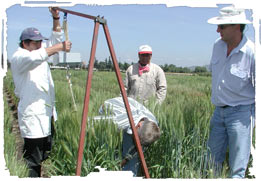CIMMYT E-News, vol 2 no. 9, September 2005
 Techniques from maize may make better wheats.
Techniques from maize may make better wheats.
Wheat farmers do not want their crop to fall over before the grain can be harvested. This condition, lodging, happens when grain weight becomes too heavy for the plant to support, bending the whole plant and limiting yields. In high yielding systems where farmers are able to input nitrogen fertilizer and water, the grain spike gets heavy and the plant can fall over. Big wheat spikes and resistance to lodging are both CIMMYT wheat breeding goals.
David Bergvinson specializes in insect pests in maize, where lodging is also a constraint and insects can exacerbate the problem by damaging a plant’s root system. Scientists have developed several techniques to measure the strength of the roots in maize. Bergvinson decided to try a maize technique on wheat.
“Variety is the spice of life,” says Bergvinson, regarding his shift from maize to wheat for this experiment, “Often we take for granted established techniques within our own crop of research without looking beyond to see how these can be applied to address important issues in other crops.”

With wheat breeder and colleague Richard Trethowan, Bergvinson used an electronic balance or scale to measure the strength of the crown, where the roots branch out into the soil, by pulling vertically on the plant until it is uprooted. In addition, they tested the stem toughness at the base of the plant.
In this literally ground-breaking experiment, Bergvinson and Trethowan hypothesize that wheat which performs well, that is takes the most force to uproot it, should also resist lodging. So far, they have tested fifty wheat lines at three of CIMMYT’s wheat stations in Mexico, all with different environmental and soil conditions. Next season, they hope to confirm the results with further tests at CIMMYT’s field station near Ciudad Obregon.
Although the results are not final, synthetic wheats, bred from durum wheat and wild relatives of wheat, appear to have stood up well in both tests. Synthetics are also known for their ability to withstand drought stress. Wheat lines known to fall prey to lodging performed poorly in the tests, indicating that this relatively straightforward measurement can potentially be used to screen and eliminate lodging susceptible wheats in the breeding program.
 Capacity development
Capacity development 
